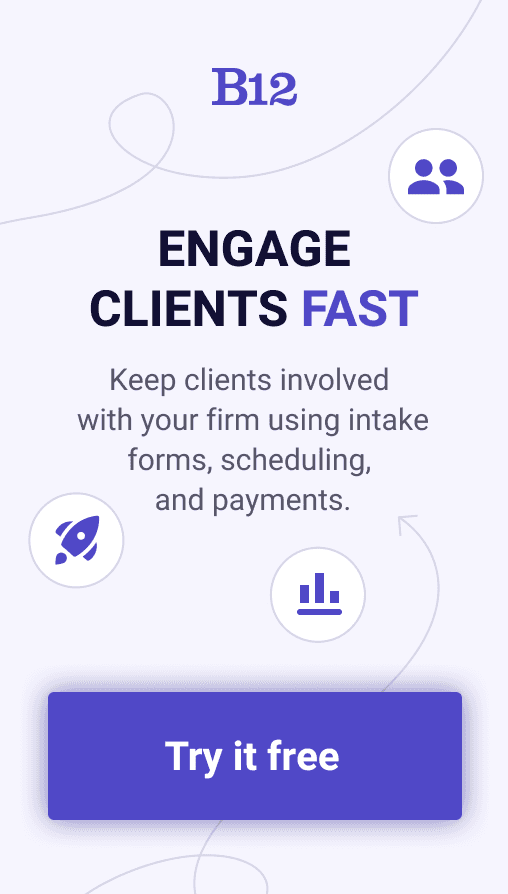Build an AI website in 60 seconds
AI generates your personalized website instantly with built-in scheduling, payments, email marketing, and more.
Start for free
How to write effective follow-up emails

Have you ever sent an important email, only to hear crickets in response? It can be frustrating. It can leave you feeling unsure of how to proceed. That's where a well-crafted follow-up email comes in.
Follow-up emails are an essential tool for effective communication. This holds true whether you're looking to touch base with a potential client, confirm a meeting, or inquire about a project. With follow-up emails, the reply rate is higher than the initial email by around 40%.
Keep reading to discover how to write effective follow-up emails that get results.
What is a follow-up email?
A follow-up email is a message that you send after a previous email or interaction. Its goal is to keep the communication going or re-establish contact if the recipient didn't respond to your initial message. Follow-up emails can be used to follow up on leads or inquiries. You can also send follow-up emails after job applications or even to thank someone for their time.
Writing a follow-up email can be daunting, especially when you're not sure what to say or how to say it. This is where effective communication comes into play.
Why are follow-up emails important?
Follow-up emails help you maintain an ongoing professional relationship with your audience. This is true whether you’re sending the email to your customers, clients, or colleagues. They also help you stay top-of-mind and show that you are proactive and invested in their success. Follow-up emails are an opportunity to engage your audience and demonstrate your value, expertise, and professionalism.
When to send a follow-up email?
The timing of a follow-up email is crucial to its success. You don't want to send it too soon or too late. This can impact how your audience responds to your message. Determine the appropriate time frame first before sending a follow-up email. Consider the context of your interaction, the urgency of the issue, and the recipient's availability. Remember to be respectful of their time and follow up only when it's necessary.
Planning and preparation
Before you hit the send button, take the time to plan and prepare the perfect follow-up email using these steps.
Define your follow-up email’s purpose
Before you start writing, know your follow-up email’s purpose. Are you scheduling a meeting? Are you requesting additional information? Or maybe you’re sending a proposal? Make sure your email serves a clear purpose and aligns with your overall goal.
Identify your target audience
Think about who your email is intended for and tailor your message accordingly. You should use different language, tone, and formatting based on your recipients' preferences and level of familiarity with you and your business.
Decide the tone and style of your email
The tone and style of your email should match your brand's voice and culture. Make it consistent across all your communication channels. Let’s say you're a law firm or financial institution. Then you may want to stick to a more formal tone and style. Meanwhile, a startup or tech company could go for a more casual, quirky tone.
Determine the ideal time to send your follow-up email
The timing of your polite follow-up email can make a huge difference in how effective it is. You don't want to send it too soon. This can come across as pushy. But you also don't want to wait too long. Why? Well, your recipient may have forgotten about your original message. So aim to wait 2-3 business days before sending a follow-up.
Writing an effective follow-up email template
Done with planning and preparation? Then it's time to actually write a follow-up email. Here are tips for crafting an email that will catch the recipient's attention and achieve your desired outcome.
Craft an attention-grabbing subject line
The subject line is the first thing your recipient will see and will determine whether they open your email or not. Make it clear and concise. Try to pique their interest. Avoid using deceptive or clickbait-sounding subject lines, which can damage your credibility. Plus, don't use the same subject line every time; spice it up instead and give recipients some variety.
Start with a polite greeting
Start your email with a warm and friendly greeting. For instance, "Hello" or "Hi". This sets a positive tone for the rest of the email. Plus, it shows that you are respectful and courteous. Address the recipient by their name if possible, rather than using a generic greeting.
Personalize your email
Show that you have put some thought and effort into the email by personalizing it. Reference any previous interactions or conversations you've had with the recipient, include their job title, and use their name throughout the email. This will make them feel valued and increase the chances of a positive response.
Provide context
In the body of the email, provide context for why you are reaching out. Recap any relevant information or previous correspondence, and explain why you are following up. Be clear and concise, and avoid vague or generic language. Make sure your recipient understands your email’s purpose and what you are asking for.
Include a clear call to action (CTA)
End your email with a clear call to action. The CTA should clearly tell the recipient what you want them to do next. Be specific and direct. Also, make it easy for them to take action. For example, if you are asking for a meeting, provide some possible dates and times. If you are asking for a response, give them a deadline.
Proofread and edit your email
Before hitting send, take the time to proofread and edit your email. Check for spelling or grammar errors. And make sure the formatting is clean and professional. Read through the email from the recipient's point of view, and consider their perspective. Is your message clear and easy to understand? How can you improve the email to make it more effective?
By following these tips, you can write effective follow-up email templates that catch the recipient's attention and achieve your desired outcome. Remember to be polite, courteous, and clear. Also, personalize your message. A little planning and preparation are all it takes. Consequently, your follow-up emails will help you build stronger relationships and achieve your goals.
How to send a follow-up email without being pushy
Follow-up emails are essential to any communication strategy. They help you maintain relationships with your prospects, customers, or partners. However, the key to sending an effective sales follow-up email is to do so without being pushy.
When to send a gentle reminder
Consider the timing. Haven't heard back from your recipient after a reasonable amount of time? Then it's appropriate to send a gentle reminder. However, be careful not to send too many reminders. Doing so can come across as annoying and lead to a negative response. Instead, try to space your sales follow-up emails out by several days or even weeks.
How to frame your follow-up message
Frame the message of your follow-up email politely and professionally. Begin by restating the purpose of your email and thanking them for their time. Then, briefly recap the previous exchange to ensure that they remember the context.
Be courteous and respectful
It's essential to be polite and respectful in your follow-up email. Remember that the recipient is under no obligation to respond to you. Avoid using language that is pushy, aggressive, or entitled. Instead, show gratitude and express empathy.
Soften your language
To avoid sounding pushy in your follow-up email, be sure to soften your language. Use words and phrases that convey respect and gratitude. Avoid saying, "When can you respond?". As an alternative, you could say, "Would it be possible to hear back from you on this matter?". By using softer language, you are more likely to receive a positive response.
Remember, the key is to approach your communication courteously and respectfully. This involves taking into account the recipient’s feelings. Doing so will help build positive relationships.
Making your email stand out for follow-up success
A follow-up email must be memorable and stand out from the rest of the crowded inbox.
Use eye-catching visuals
Including relevant visuals in your email can help draw attention to your message and make it more engaging. This can include images, graphs, or even a short video. Just make sure the visuals align with your message and help to reinforce your point.
Offer value
To make your follow-up email more compelling, offer value to the recipient. This could be a helpful resource or a special incentive to take action. By providing value, you increase the chances that your email will be seen as helpful rather than annoying.
Keep it short and sweet
People are busy. They don't have time to read lengthy follow-ups. So keep your follow-up message short. Aim for a maximum of a few paragraphs to keep your message clear and concise. This will make it easier for recipients to quickly digest your message. In turn, they can take action faster.
Avoid jargon and buzzwords
Using industry jargon or trendy buzzwords can make your email sound generic and insincere. Instead, use plain language and simple words to communicate your message. This will help establish a personal connection with the recipient and make your message more authentic.
Follow up with a phone call
Sometimes, the most effective way to follow up is with a phone call. This shows that you're willing to go the extra mile to make a connection. And it allows you to have a more personal conversation with the recipient. Just make sure to ask for permission before calling. And be respectful of the recipient's time.
Remember to be patient and persistent. And don't be afraid to get creative with your messaging. With practice, you'll become an expert at launching an effective follow-up campaign.
Streamline your email efforts with B12
Sending a well-crafted follow-up email can make all the difference in getting the response or outcome you desire. Follow the guidelines we've provided to improve your chances of success and build long-lasting relationships. Don't underestimate the power of follow-up emails and start crafting your next email today!
At B12, we not only help you launch a professional website, but we also enable you to more efficiently do routine email tasks. With B12, you can send engaging follow-up emails from pre-written templates, complete with your branding. We make it convenient to view your interaction history with contacts and plan next steps. Get started in 60 seconds.
Attract, win, and serve more clients
Receive helpful resources directly to your inbox to help you succeed online.
Draft your site in 60 seconds
Get an AI website made specifically for you that's free to launch.
Start for free ✨No credit card required
Spend less time on your website and more time growing your business
Let B12 set up your professional online presence with everything you need to attract, win, and serve clients.




